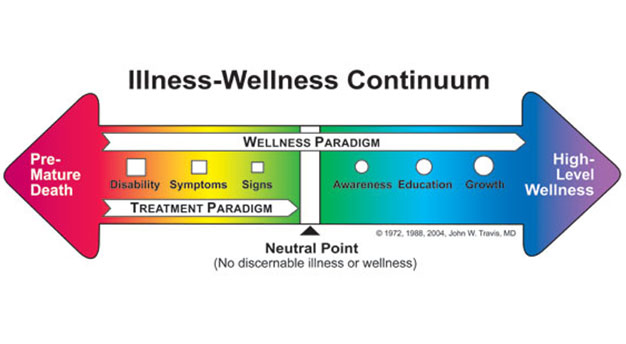
The Illness-Wellness Continuum
(Courtesy: John Travis)
“When you are at peace with yourself, it is virtually impossible to do things to yourself that are destructive.” ~ Dr. Wayne W. Dyer, MD
Most of us think of Wellness in terms of illness; we assume that the absence of illness indicates Wellness. There are actually many degrees of Wellness, just as there are many degrees of illness. The Illness/Wellness Continuum (below) illustrate the relationship of the treatment paradigm to the Wellness paradigm.
Moving from the center to the left shows a progressively worsening state of health. Moving to the right of center indicates increasing levels of health and wellbeing. The treatment paradigm (drugs, herbs, surgery, psychotherapy, acupuncture, and so on) can bring you up to the neutral point, where the symptoms of disease have been alleviated.
The wellness paradigm, which can be utilized at any point on the continuum, helps you move toward higher levels of Wellness.
The wellness paradigm directs you beyond neutral and encourages you to move as far to the right as possible. It is not meant to replace the treatment paradigm on the left side of the continuum, but to work in harmony with it. If you are ill, then treatment is important, but do not stop at the neutral point. Use the wellness paradigm to move toward high-level wellness.
Even though people often lack physical symptoms, they may still be bored, depressed, tense, anxious, or simply unhappy with their lives. Such emotional states often set the stage for physical and mental disease. Even cancer can be brought on by excessive stress that weakens the immune system. Negative emotional states can also lead to abuse of the body through smoking, over drinking alcohol, and overeating – attempts to substitute for other more basic human needs such as acknowledgment and respect, a stimulating and supportive environment, and a sense of purpose and meaning.
Wellness is not a static state. High-level wellness involves giving good care to your physical self, using your mind constructively, expressing your emotions effectively, being creatively involved with those around you, and being concerned about your physical, psychological, and spiritual environments. In fact, it is not so much where you are on the continuum, but which direction you are facing. High-level wellness does not preclude periods of illness and weakness, nor does it attempt to deny that death is a natural part of life.
Finding this answer is the difference between whether you are entering the “Zone of Wellness” or you are stuck in the “Zone of Illness.”
Darkness is not dispelled through darkness. Only light dispels darkness. For darkness is only absence of light. There is no entity to darkness. Similarly Illness is only an absence of Wellness.

Wellness is our Birthright
“There are two ways to live your life. One is as though nothing is a miracle. The other is as though everything is a miracle.” ~ Albert Einstein
Wellness is the right and privilege of everyone. There is no prerequisite for it other than your free choice. The “well” being is not necessarily the strong, the brave, the successful, the young, the whole, or even the illness-free being. A person can be living a process of wellness and yet be physically handicapped; aged; scared in the face of challenge; in pain; imperfect. No matter what your current state of health, you can begin to appreciate yourself as a growing, changing person and allow yourself to move tow and a happier life and positive health.
Wellness is never a static state. You do not just get well or stay well. There are many degrees or levels of wellness, just as there are degrees of illness. Nor is wellness simply the absence of disease. While people often lack physical symptoms, they may still be bored depressed, tense, anxious, or generally unhappy with their lives. These emotional states often set the stage for physical disease through the lowering of the body’s resistance. The same feelings can also lead to abuses like smoking, excessive alcohol or drug use, and overeating. But these symptoms and behaviors represent only the tip of the iceberg.
They are the surface indication of underlying human needs for such things as recognition from others, a stimulating environment, caring and affection from friends, a sense of purpose, and self-acceptance.
Diseases and symptoms are not really the problem. They are actually the body-mind-spirit’s attempt to solve a problem – they are a message from the subconscious to the conscious.
Much of contemporary medical practice is involved with chipping away at surface needs. Its orientation is toward treating and eliminating the evidence of disease, and this is important. But it is not enough. It is essential to look below the surface signs to address the real needs. Wellness extends the definition of health to encompass a process of integration characterized by awareness, education, and growth.
Moving toward high-level wellness will involve the three steps of awareness, education, and growth. This website is designed to get you moving. It is an invitation to you to consider illness and health in a bigger context: that of your connection with other people as well as with the entire planet. As we understand it, health is a result of a dynamic energy exchange between the individual and everything in creation. People cannot live well while remaining isolated from other people and things around them. We are interdependent elements in a living system. When any part is ill or healthy, it necessarily affects the energy, and changes the health, of the whole.